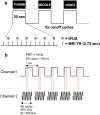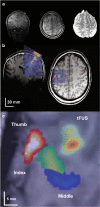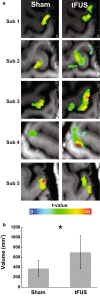Effects of transcranial focused ultrasound on human primary motor cortex using 7T fMRI: a pilot study
- PMID: 30217150
- PMCID: PMC6137744
- DOI: 10.1186/s12868-018-0456-6
Effects of transcranial focused ultrasound on human primary motor cortex using 7T fMRI: a pilot study
Abstract
Background: Transcranial focused ultrasound (tFUS) is a new non-invasive neuromodulation technique that uses mechanical energy to modulate neuronal excitability with high spatial precision. tFUS has been shown to be capable of modulating EEG brain activity in humans that is spatially restricted, and here, we use 7T MRI to extend these findings. We test the effect of tFUS on 7T BOLD fMRI signals from individual finger representations in the human primary motor cortex (M1) and connected cortical motor regions. Participants (N = 5) performed a cued finger tapping task in a 7T MRI scanner with their thumb, index, and middle fingers to produce a BOLD signal for individual M1 finger representations during either tFUS or sham neuromodulation to the thumb representation.
Results: Results demonstrated a statistically significant increase in activation volume of the M1 thumb representation for the tFUS condition as compared to sham. No differences in percent BOLD changes were found. This effect was spatially confined as the index and middle finger M1 finger representations did not show similar significant changes in either percent change or activation volume. No effects were seen during tFUS to M1 in the supplementary motor area or the dorsal premotor cortex.
Conclusions: Single element tFUS can be paired with high field MRI that does not induce significant artifact. tFUS increases activation volumes of the targeted finger representation that is spatially restricted within M1 but does not extend to functionally connected motor regions. Trial registration ClinicalTrials.gov NCT03634631 08/14/18.
Keywords: 7T fMRI; BOLD; Human; Motor cortex; Neuromodulation; Ultrasound.
Figures




Similar articles
-
The Myelin Content of the Human Precentral Hand Knob Reflects Interindividual Differences in Manual Motor Control at the Physiological and Behavioral Level.J Neurosci. 2021 Apr 7;41(14):3163-3179. doi: 10.1523/JNEUROSCI.0390-20.2021. Epub 2021 Mar 2. J Neurosci. 2021. PMID: 33653698 Free PMC article.
-
7T Spin-echo BOLD fMRI enhances spatial specificity in the human motor cortex during finger movement tasks.Neuroimage. 2025 Aug 15;317:121351. doi: 10.1016/j.neuroimage.2025.121351. Epub 2025 Jun 26. Neuroimage. 2025. PMID: 40581274
-
Mechanical flutter stimulation induces a lasting response in the sensorimotor cortex as revealed with BOLD fMRI.Hum Brain Mapp. 2013 Nov;34(11):2767-74. doi: 10.1002/hbm.22102. Epub 2012 May 19. Hum Brain Mapp. 2013. PMID: 22611041 Free PMC article.
-
Safety of transcranial focused ultrasound stimulation: A systematic review of the state of knowledge from both human and animal studies.Brain Stimul. 2019 Nov-Dec;12(6):1367-1380. doi: 10.1016/j.brs.2019.07.024. Epub 2019 Jul 31. Brain Stimul. 2019. PMID: 31401074
-
Advances in transcranial focused ultrasound neuromodulation for mental disorders.Prog Neuropsychopharmacol Biol Psychiatry. 2025 Jan 10;136:111244. doi: 10.1016/j.pnpbp.2024.111244. Epub 2025 Jan 3. Prog Neuropsychopharmacol Biol Psychiatry. 2025. PMID: 39756638 Review.
Cited by
-
Differential dose responses of transcranial focused ultrasound at brain regions indicate causal interactions.Brain Stimul. 2022 Nov-Dec;15(6):1552-1564. doi: 10.1016/j.brs.2022.12.003. Epub 2022 Dec 7. Brain Stimul. 2022. PMID: 36496128 Free PMC article.
-
Transcranial Focused Ultrasound (tFUS) and Transcranial Unfocused Ultrasound (tUS) Neuromodulation: From Theoretical Principles to Stimulation Practices.Front Neurol. 2019 Jun 11;10:549. doi: 10.3389/fneur.2019.00549. eCollection 2019. Front Neurol. 2019. PMID: 31244747 Free PMC article. Review.
-
First evidence of long-term effects of transcranial pulse stimulation (TPS) on the human brain.J Transl Med. 2022 Jan 15;20(1):26. doi: 10.1186/s12967-021-03222-5. J Transl Med. 2022. PMID: 35033118 Free PMC article.
-
Low-Intensity Focused Ultrasound Neuromodulation for Stroke Recovery: A Novel Deep Brain Stimulation Approach for Neurorehabilitation?IEEE Open J Eng Med Biol. 2023 Apr 5;4:300-318. doi: 10.1109/OJEMB.2023.3263690. eCollection 2023. IEEE Open J Eng Med Biol. 2023. PMID: 38196977 Free PMC article.
-
Transcranial Focused Ultrasound Neuromodulation of Voluntary Movement-Related Cortical Activity in Humans.IEEE Trans Biomed Eng. 2021 Jun;68(6):1923-1931. doi: 10.1109/TBME.2020.3030892. Epub 2021 May 21. IEEE Trans Biomed Eng. 2021. PMID: 33055021 Free PMC article.
References
Publication types
MeSH terms
Substances
Associated data
LinkOut - more resources
Full Text Sources
Other Literature Sources
Medical

